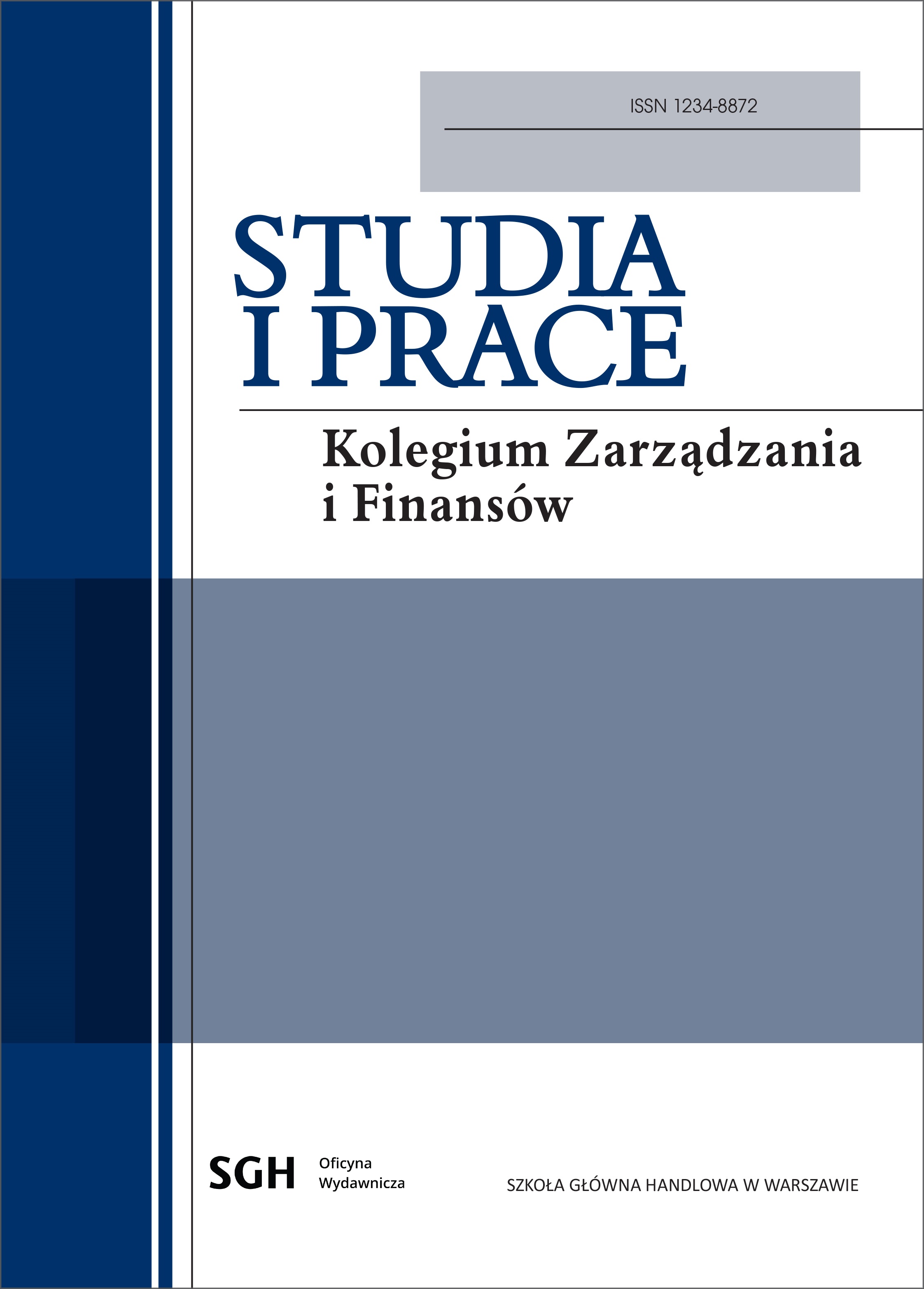Modelowanie struktury terminowej stóp procentowych w ramach dyrektywy Solvency II na przykładzie Polski
DOI:
https://doi.org/10.33119/SIP.2021.182.3Słowa kluczowe:
Solvency II, struktura terminowa stóp procentowych, model Smitha-Wilsona, wycena zobowiązańAbstrakt
Niniejsza praca dotyczy modelowania struktury terminowej stóp procentowych w kontekście dyrektywy Solvency II. Celem artykułu jest przedstawienie analizy porównawczej struktury terminowej stóp procentowych modelowanej za pomocą modelu Smitha-Wilsona oraz dwóch innych modeli dość powszechnie stosowanych w praktyce, na przykładzie rynku polskiego. Przeprowadzona analiza potwierdza zasadność stosowania modelu Smitha-Wilsona przez zakłady ubezpieczeń i towarzystwa emerytalne w modelowaniu struktury terminowej stóp procentowych na rynku polskim w kontekście dyrektywy Solvency II.
Downloads
Bibliografia
2. Balter A., Pelsser A., Schotman P. [2021], What Does a Term Structure Model Imply about Very Long-Term Interest Rates?, „Journal of Empirical Finance”, doi: https://doi.org/10.1016/j.jempfin.2021.03.006
3. Batista C. M. [2015], How Do Current Term Structure Models Behave Beyond the Last Liquid Point? A Comparison of the DNS and Smith-Wilson Methods, praca magisterska, Nova School of Business and Economics Maastricht University, https://www.semanticscholar.org/paper/How-do-current-term-structure-model-behave-beyond-A-Batista/e547c0ccdeef12fcf3864f-57cb3f8869d22ebd61
4. Beers R. H. A. van, Elshof W. [2012], Evaluating the Solvency Capital Requirement of Interest Rate Risk in Solvency II, Milliman Research Report, Amsterdam.
5. Broeders D. W. G. A., de Jong F., Schotman P. [2016], Interest Rate Models for Pension and Insurance Regulation, Netspar Industry Paper Series, Design 56, https://www.netspar.nl/assets/uploads/Netspar_Design_56_WEB.pdf
6. Chang C. K., Li J. T. [2011], Extrapolation of Long-Term Risk-Free Interest Rates: A Case Study for the Taiwan Insurance Market, „African Journal of Business Management”, 5 (26), 10645–10656, https://academicjournals.org/article/article1380531188_Chand%20and%20Li.pdf
7. Chrzanowska M. K., Michalska A., Wielgosz M. [2013], Wyniki badania wpływu potencjalnych rozwiązań regulacyjnych dla tzw. długoterminowych produktów ubezpieczeniowych zawierających gwarancje (Long-Term Guarantees Assessment – LTGA) na krajowym rynku ubezpieczeniowym, Urząd Komisji Nadzoru Finansowego, Warszawa.
8. Dziwok E., Wirth M. [2020], Different Approaches to the Reference Yield Curve Construction – and Their Application into Fund Transfer Pricing Mechanism, Contemporary Trends and Challenges in Finance, proceedings from the 5th Wroclaw International Conference in Finance, https://www.researchgate.net/publication/341195911_Different_Approaches_to_the_Reference_Yield_Curve_Construction-And_Their_Application_into_Fund_Transfer_Pricing_Mechanism
9. EUNUPPE [2020], Technical Documentation of the Methodology to Derive EIOPA’s Risk-Free Interest Rate Term Structures, Europejski Urząd Nadzoru Ubezpieczeń i Pracowniczych Programów Emerytalnych, Frankfurt am Main, https://www.eiopa.europa.eu/sites/default/files/risk_free_interest_rate/21.08.2020_-_technical_documentation.pdf
10. FINANSTILSYNET – The Financial Supervisory Authority of Norway [2010], A Technical Note on the Smith-Wilson Method, Oslo, http://janroman.dhis.org/finance/Smith%20Wilson/A_Technical_Note_on_the_Smith-Wilson_Method_100701.pdf
11. Gach F. [2016], Note on the Smith-Wilson Interest Rate Curve, „International Journal of Theoretical and Applied Finance”, 19 (07), doi:https://doi.org/10.1142/S0219024916500394
12. Herold W., Wirth M. [2015], Asset Liability Management and Interest Rate Risk in Solvency II – an Empirical Study, Workshops – Proceedings of OeNB Workshops 20, s. 71–85.
13. Jorgensen P. L. [2018], An Analysis of the Solvency II Regulatory Framework’s Smith-Wilson Model for the Term Structure of Risk-Free Interest Rates, „Journal of Banking and Finance”, 97, s. 219–237.
14. Kliber P. [2009], Estymacja struktury terminowej stóp procentowych w Polsce, „Bank i Kredyt”, 40 (1), s. 109–126.
15. Kliber A. M., Kliber P. [2010], Podstawy modelowania struktury terminowej stóp procentowych, Wydawnictwo Uniwersytetu Ekonomicznego w Poznaniu, Poznań.
16. Lageras A., Lindholm M. [2016], Issues with the Smith-Wilson Method, „Insurance: Mathematics and Economics”, 71, s. 93–102.
17. Magurean M. M. [2016], Extrapolation Methods of the Term Structure of Interest Rates under Solvency II, Sapienza Universita di Roma, Rzym.
18. Murray K., MacDonnell B., Phelan E. [2019], Solvency II under Review: Part 1. Extrapolation of the Risk-Free Rate Curve, Milliman Report.
19. Nelson C. R., Siegel A. F. [1987], Pasimonious Modeling of Yield Curves, „Journal of Business”, 60, s. 473–489.
20. Stroiński K. [2008], Solvency II. Nadzór, wymogi zarządcze oraz nadzór grupowy, Polska Izba Ubezpieczeń, Deloitte Advisory, Warszawa, https://docplayer.pl/6151265‑Solvency-ii-nadzor-wymogi-zarzadcze-oraz-nadzor-grupowy-polska-izba-ubezpieczen-deloitte-advisory-sp-z-o-o-krzysztof-stroinski.html
21. Svensson L. E. O. [1994], Estimating and Interpreting forward Interest Rates: Sweden 1992–1994, Working Paper, no. 4871, NBER, Cambridge.
22. Wahlers M. [2013], Valuation of Long-term Liabilities under Solvency II – Extrapolation Methods for the European Interest Rate Market, praca magisterska, Maastricht University, Maastricht, https://www.netspar.nl/assets/uploads/044_MSc_Marie_Wahlers.pdf









